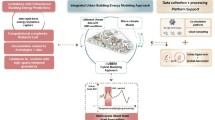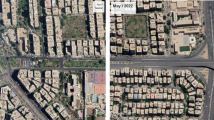Abstract
Most of the building energy models are not suited to properly integrate local urban ambient conditions; thus, this study initiates a sensitivity analysis of the heating and cooling needs and operative temperature of buildings to local radiative, thermal and aeraulic external conditions. These conditions were estimated using the possibilities of a building energy model (based on the BuildSysPro Modelica library) or derived from microclimatic simulations (SOLENE microclimat) for generic isolated or urban buildings. The thermal behaviors of both energy-inefficient and energy-efficient buildings in summer and winter are examined. The results show major effects of short- and long-wave radiative heat transfers as well as aeraulics. According to present results, and given current urban growth and climate change challenges as well as the development of energy conservative buildings, this last point may become particularly critical in the future.
Similar content being viewed by others
References
Bouyer J, Inard C, Musy M (2011). Microclimatic coupling as a solution to improve building energy simulation in an urban context. Energy and Buildings, 43: 1549–1559.
CNRM (2015). Town energy balance. Available at https://doi.org/www.umr-cnrm.fr/spip.php?article199/
Cóstola D, Blocken B, Ohba M, Hensen JLM (2010). Uncertainty in airflow rate calculations due to the use of surface-averaged pressure coefficients. Energy and Buildings, 42: 881–888.
Frayssinet L, Kuznik F, Hubert J-L, Milliez M, Roux J-J (2017). Adaptation of building envelope models for energy simulation at district scale. Energy Procedia, 122: 307–312.
Jacob J, Sagaut P (2018). Wind comfort assessment by means of large eddy simulation with lattice Boltzmann method in full scale city area. Building and Environment, 139: 110–124.
Malys L, Musy M, Inard C (2015). Microclimate and building energy consumption: Study of different coupling methods. Advances in Building Energy Research, 9: 151–174.
Masson V (2000). A physically-based scheme for the urban energy budget in atmospheric models. Boundary-Layer Meteorology, 94: 357–397.
Merlier L, Jacob J, Sagaut P (2018). Lattice-Boltzmann Large-Eddy Simulation of pollutant dispersion in street canyons including tree planting effects. Atmospheric Environment, 195: 89–103.
Merlier L, Frayssinet L, Johannes K, Kuznik F (2019a). On the impact of local microclimate on building performance simulation. Part I: Prediction of building external conditions. Building Simulation, https://doi.org/10.1007/s12273-019-0507-7.
Merlier L, Jacob J, Sagaut P (2019b). Lattice-Boltzmann large-eddy simulation of pollutant dispersion in complex urban environment with dense gas effect: Model evaluation and flow analysis. Building and Environment, 148: 634–652.
Mirsadeghi M, Cóstola D, Blocken B, Hensen JLM (2013). Review of external convective heat transfer coefficient models in building energy simulation programs: implementation and uncertainty. Applied Thermal Engineering, 56: 134–151.
Morille B, Lauzet N, Musy M (2015). SOLENE-microclimate: A tool to evaluate envelopes efficiency on energy consumption at district scale. Energy Procedia, 78: 1165–1170.
Musy M, Malys L, Morille B, Inard C (2015). The use of SOLENE-microclimat model to assess adaptation strategies at the district scale. Urban Climate, 14: 213–223.
Obrecht C, Kuznik F, Merlier L, Roux J-J, Tourancheau B (2015). Towards aeraulic simulations at urban scale using the lattice Boltzmann method. Environmental Fluid Mechanics, 15: 753–770.
Pigeon G, Zibouche K, Bueno B, Le Bras J, Masson V (2014). Improving the capabilities of the Town Energy Balance model with up-to-date building energy simulation algorithms: An application to a set of representative buildings in Paris. Energy and Buildings, 76: 1–14.
Plessis G, Kaemmerlen A, Lindsay A (2014). BuildSysPro: A Modelica library for modelling buildings and energy systems. In: Proceedings of the 10th International Modelica Conference, Lund, Sweden, pp. 1161–1169.
Ramponi R, Gaetani I, Angelotti A (2014). Influence of the urban environment on the effectiveness of natural night-ventilation of an office building. Energy and Buildings, 78: 25–34.
Rochard U, Shanthirablan S, Brejon C, Chateau le Bras M (2015). Bâtiments résidentiels: Typologie du parc existant et solutions exemplaires pour la rénovation énergétique en France. Technical Report.
Salvati A, Coch Roura H, Cecere C (2017). Assessing the urban heat island and its energy impact on residential buildings in Mediterranean climate: Barcelona case study. Energy and Buildings, 146: 38–54.
Schumann M, Charrier B, Plessis G, Wall-Ribot B (2016). BuildSysPro un bibliothé Modelica open source pour l’énergétique des bâtiments et des quartiers. In: Proceedings of the IBPSA France Conference. Marne-la-Vallée, France.
Sun Y, Heo Y, Xie H, Tan M, Wu J, Augenbroe G (2011). Uncertainity quantification of microclimate variables in building energy simulation. In: Proceedings of the 12th International IBPSA Building Simulation Conference, Sydney, Australia, pp. 2423–2430.
Yang X, Zhao L, Bruse M, Meng Q (2012). An integrated simulation method for building energy performance assessment in urban environments. Energy and Buildings, 54: 243–251.
Zhai Z, Chen Q (2005). Performance of coupled building energy and CFD simulations. Energy and Buildings, 37: 333–344.
Zinzi M, Carnielo E, Mattoni B (2018). On the relation between urban climate and energy performance of buildings. A three-years experience in Rome, Italy. Applied Energy, 221: 148–160.
Acknowledgements
The authors sincerely thank Jean-Luc Hubert and Maya Milliez from the EDF R&D and BHEE for their support when preparing this work.
Author information
Authors and Affiliations
Corresponding author
Rights and permissions
About this article
Cite this article
Merlier, L., Frayssinet, L., Johannes, K. et al. On the impact of local microclimate on building performance simulation. Part II: Effect of external conditions on the dynamic thermal behavior of buildings. Build. Simul. 12, 747–757 (2019). https://doi.org/10.1007/s12273-019-0508-6
Received:
Revised:
Accepted:
Published:
Issue Date:
DOI: https://doi.org/10.1007/s12273-019-0508-6




